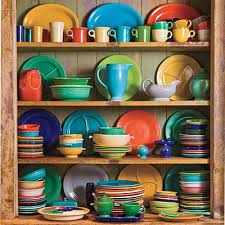The “Blue Plate” special is a low-priced restaurant meal, but not necessarily served on a blue plate. One of the origins of the term refers to the Depression and a manufacturer who produced plates divided into separate sections for each part of a meal. My wife would be in favor of this innovation because it would keep her food “from touching each other.” For an unknown reason, these inexpensive, frozen-dinner-like-trays were only available in the color blue. My wife prefers her meals on a yellow plate. When I set the table, she gets yellow and I choose whatever color is at the top of the stack. Maybe I should be more selective?
Our kitchen cabinets are filled with Fiestaware, a line of ceramic glazed dinnerware manufactured and marketed by the Homer Laughlin China Company of Newell, West Virginia. According to Wikipedia, it was first introduced in 1936, with a hiatus in production from 1973 to 1985. Fiesta is known for its distinctive Art Deco style of concentric circles and solid colors. In 2002, The New York Times called it the most collected brand of china in the United States. One of the more unusual colors in our collection is Brilliant Red that has a detectable amount of uranium oxide in its glaze. During WWII, our government took control of uranium for development of the atom bomb, and confiscated Laughlin’s stock. This interruption of production fueled rumors of radioactivity, but the glaze in truth is relatively safe.
My wife started with 3 tumblers that were passed down from her grandparents. She then soon got a set as a gift, and her mother added to it by collecting Fiesta at garage sales, auctions, and antique stores. As a result, her mother and sister both ended up with cabinets full, while almost every meal my wife serves is on these festive pieces. It’s just a matter of what color you want your plate, dish, and cup to be, so mixing and matching is the fun part of setting the table. In fact, there are 37 different pieces, including candle holders, bud vases, serving bowls, ash trays, nested mixing bowls, gravy servers, butter dishes, salt & pepper shakers, cream & sugars, salad plates, soup bowls, saucers, pitchers, tea pots, divided plates, carafes, relish trays, and platters to name just a few of the options. You can also chose from an assortment of colors like yellow, light blue, dark blue, and red, along with the less-common shades of creams, greens and browns. Modern day production adds purple, pink, orange, lime, black, and aqua to the array of colors available. We could easily have served all the guests at the Last Supper in all one color or any combination from our vast collection that are primarily antiques.
As I was listening to the radio this morning, there was a discussion about the psychology of color relative to appetite. It explains why my wife prefers a yellow plate. Food apparently looks better on bright colors, and this is why most restaurants favor golds, yellows, and reds in their decorating schemes. Blue is the least appealing color, and even sitting in a dining area with the walls painted a shade of blue will suppress your appetite. You also will be less likely to clean your plate if it’s blue. Perhaps this psychology applied to feeding the hungry during the Depression years and maybe even led to the popularity of “The Blues” style of music. Bottom line: if you’re trying to diet, choose the “Blue Plate Special.” However, if you want that special glow – go with “Radioactive Red.”

Leave a Reply